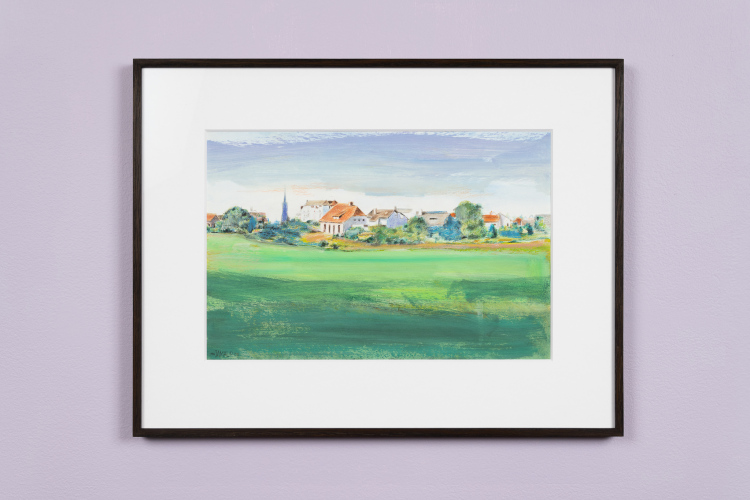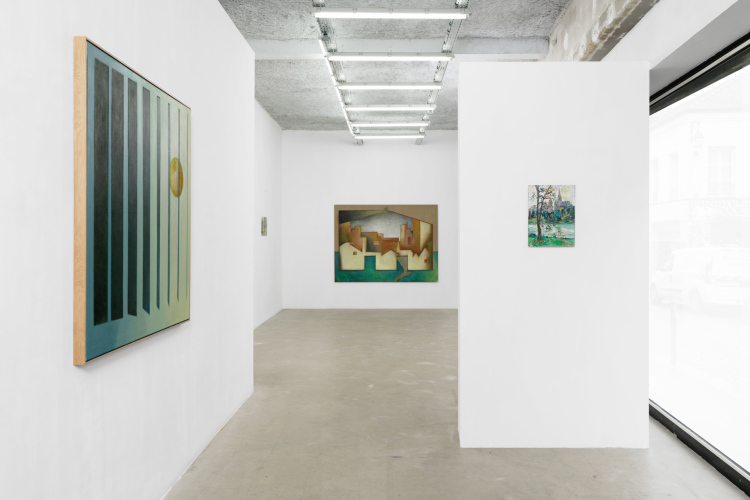Let us begin with the most apparent: a mixed-media drawing on paper depicting a landscape. Holding the single-sheet, we attest to a fleeting materiality, which could have come from a transportable aquarelle block containing many more works. Removed from context, its singularity leaves us in a predicament, and with a carte blanche for infinite ponder! Some things are obvious: the sheet in question has summoned a multitude of media treatments ranging from colored-penciled details and scruffy oil-pastel marks to broad acrylic strokes, and a pervasive watercolor atmosphere. Alongside the pleasant treatment of color we note a practical tone, and a hastiness of execution that is evidence of a hand confident to capture “life as is.” The content does not strike us as a revelation, nor a spectacle to swoon large audiences, rather, it seems to be true to common life, and convinces elegantly in this uncelebrated feat. The motivation for such work could have been the offspring to a simple desire to seize a pleasant day. The clear sky above is an indication of this at the least. Whether the painting was done in leisure, as an exercise in style, or as part of some larger endeavor we leave motivations aside for the moment.
In the foreground a barren land covered with generous washes of green and brown pulls us into a picture of possibilities. Beyond it, the artist steers our pupils to rest on the horizon line – conventionally so. Here, an unremarkable town has shyly tucked itself away behind some trimmings. We squint to survey the elements: a modestly-sized apartment building or town hall with reassuring angular architecture, a trail of miscellaneous bushes and trees that wall some vaguely discernible family houses, and the faint town church that sinks into a purple mist – projecting its omnipresence slightly above the rest of the rabble. This accumulated sort recalls an ordinary place; with an affirmation towards all things structured and orderly, as is standard for any ordinary place. Clues drawn from the inherent architectural characteristics and the surrounding landscape lead us to posit a potential geography. Any other setting than Germany is inconceivable. Emboldened by our conclusion, our thoughts trail off past the hermetics of the picture frame to a larger vicinity of endlessly ploughed fields of the greatest agricultural merit. The excursion takes us to encounters with astonishingly tall walls of evergreens that intimidate and awe. Here lays the inspiration to all things Gothic, we figure.
Snapping back to the picture at hand, our attention is drawn to the signature at the bottom left. The work is accredited to a “Mohsen Jamal”, dating to 1986. We successfully decipher the apparent! Having been given as a clue nothing more than a name with a strange ring to it, we determine to carry our guesswork about the origins of this drawing through to its very creator. From the prompt naturalism of the outdoor scene, we deduce that the work could have taken place en plein air. What could have led the artist to such a place; such a small town in the middle of Germany? Did the landscape hold a personal value? Could a small place such as this have had enough historical or collective significance to draw a faraway visit? While one may speculate further in light of these propositions (to paint a complete picture), the scenarios leave us with the sense that the work was produced by a curious passerby, a newly arrived or a guest, on a spontaneous whim to capture the unfamiliar. Whereas what someone predisposed, or cynical, to a ubiquitous setting would dismiss as mundane, holds intrigue to a fresh eye. Contrary to our prejudice, it remains plausible that this town could have been the vested habitat of a local; the proper terroir of the artist indeed.
Having entered the picture plane, we come to appreciate the view accompanied by the fragrance of a countryside unhindered by noise pollution and cosmopolitan combustion. Transfixed, inhabiting the gaze of the artist, the discrepancy between our observation-deck at the easel’s foot, and that of a withdrawn life in the distance is given neither face nor form. Shafts of windows reveal vignettes of the inner mechanisms of a town, where typical exchanges, contested relationships, and neighborly feuds abound. What separates us from yonder then, is the plateau of land that determines the cautionary distance between the viewer (brush in hand, holding sway of history-making), between spectator and the subject in the periphery, between civilization and the uncharted wild – observed as if from the trenches. Still, the village is likely unaware of our existence on the fringes. Nonetheless it is here, by the same tree that offered the artist a cool shade on a sunny day in 1986, that we hold the fruit shaped like a globe, which when held at different angles glistens with infinite possibilities.
Mirak Jamal
Berlin, November 6, 2019
 Best View in TownMirak Jamal
Best View in TownMirak Jamal